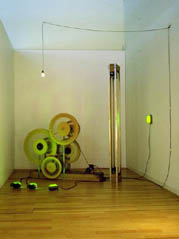
|
| Technical details: wood,
metal, LEDs, electric motor, dedicated software |
|
Bill Spinhoven's installations bear witness to a profound fascination for the tension between technology and image, and for the conditions determining twentieth-century observation. His viewing machines represent an anthology of modern, technological, observation (by enlarging or overexposing certain conditions or characteristics) and also reflect upon our position and that of art therein. It often seems that, from a deep-rooted desire to be all-seeing and with the help of our ever more sophisticated optical apparatus, we are on the way to becoming absolute viewing appliances ourselves: Spinhoven's art of observation raises the question of why we are so obsessed with optical matters; what it is that we are so keen to see, and what we are looking for: is it reality or something else, something that reaches beyond reality?
A Shot Across the Mind dealt with the desire to be able to see everything at the same time, Albert's Ark with the influence of the factor time on image and perception, and I/Eye with observing and being observed. The Logic of Life enters into the psychological confusion which arises when you look at something without knowing precisely what it is.
The Logic of Life is an enigmatic and wayward machine, in which the logic of natural movement collapses and the glance loses its bearings. The machine is only lit by LED lamps, which, controlled by a computer, flicker in various frequencies. In this sparse and changeable light, you see a construction which consists of a combination of wheels resembling film reels, in various sizes, and broad belts which connect the wheels and make them turn at high speed. The construction moves like an old-fashioned mechanism, while on the belts - strips of paper - images can be seen of a small hovering figure which makes flying movements.
However, there is something amiss in The Logic of Life: the direction of the movement and the speed of the images and wheels change, they are unpredictable, illogical, and inconsistent with the construction of the machine. They sometimes seem to turn in the wrong direction. Contrary to what our modern machinery is usually trying to make us believe, this machine seems to function anything but flawlessly.
The Logic of Life is reminiscent of a viewing machine from the 19th century, and also derives its power from the mystery of the moving image, from the tension between reality and fiction. What do you really see? What are you looking at? The machine plays the viewer's expectations off against itself. It cannot be a coincidence that the flapping figure in the images recalls heroic but ill-fated attempts to fly, or the fall of Icarus. And then there is the fact that this lonely flyer is also the image of the artist himself...
Jorinde Seijdel
|
|
